A public service program of:

A public service program of:

 Rear-Facing
Rear-FacingRear-facing car seats do a better job of protecting the head, neck, spine and back in the event of a crash. Infants are at a greater risk of injury because the spine and neck of a baby are still developing and their heads are so large in proportion to their bodies. The child is "cradled" in a rear-facing car seat protecting these important body parts, by distributing the crash forces over the entire body, according to Dr. Dennis Durbin, M.D., F.A.A.P., a pediatric emergency physician and recognized leader in pediatric trauma research.
The American Academy of Pediatrics recommends that all children under the age of 2 remain in a rear-facing car seat until he/she reaches the maximum height or weight limit allowed by the car seat manufacturer [1]. Children 2 and older should continue to ride rear-facing as long as possible.
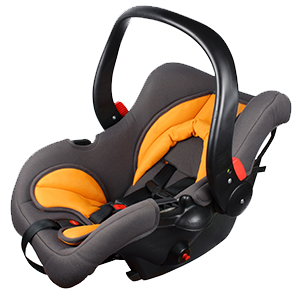
Also called infant-only seats, that can only be used facing the rear of the vehicle.
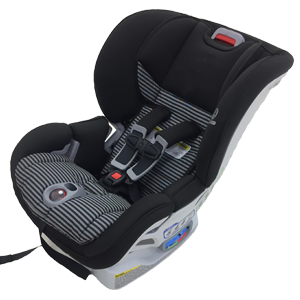
Can be used either rear or forward-facing. Convertible car seats typically have higher height and weight limits for the rear-facing position, allowing you to keep your child rear-facing for a longer period of time.
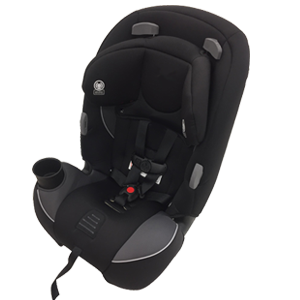
This type of seat can be used rear-facing, forward-facing and be used as a high back booster seat.
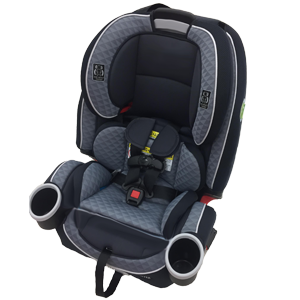
This type of seat can be used rear-facing, forward-facing and be used as a high back booster seat or backless booster seat.
All photos are for demonstration purposes only
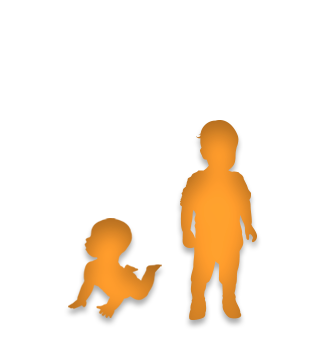

Birth – Until at least 2 years old. Keep your child rear-facing until he or she reaches the maximum height or weight limit allowed by the car seat manufacturer. (Transition to the next stage at approx. age 2).
Remember rear-facing does a better job protecting the child's head, neck, spine and back in a crash.
There is no need to rush to move on to the next car seat or booster seat.
Children under age 2 should ALWAYS ride in a rear-facing car seat in the back seat of the car. Never place a rear-facing car seat in the front seat. Consult your vehicle owner's manual for further information.
The American Academy of Pediatrics (AAP) recommends that all children under the age of 2 should remain in a rear-facing car seat, and that children 2 and older should continue to ride rear-facing as long as possible, until they reach the maximum height or weight limit allowed by the car seat manufacturer. [2]
"A rear-facing child safety seat does a better job of supporting the head, neck and spine of infants and toddlers in a crash, because it distributes the force of the collision over the entire body", according to the AAP.
When purchasing a rear-facing car seat, please note that there are different types available:
Birth – Until at least 2 years old. Keep your child rear-facing until he or she reaches the maximum height or weight limit allowed by the car seat manufacturer. (Transition to the next stage at approx. age 2).
Remember rear-facing does a better job protecting the child's head, neck, spine and back in a crash.
There is no need to rush to move on to the next car seat or booster seat.
Children under age 2 should ALWAYS ride in a rear-facing car seat in the back seat of the car. Never place a rear-facing car seat in the front seat. Consult your vehicle owner's manual for further information.
The American Academy of Pediatrics (AAP) recommends that all children under the age of 2 should remain in a rear-facing car seat, and that children 2 and older should continue to ride rear-facing as long as possible, until they reach the maximum height or weight limit allowed by the car seat manufacturer. [2]
"A rear-facing child safety seat does a better job of supporting the head, neck and spine of infants and toddlers in a crash, because it distributes the force of the collision over the entire body", according to the AAP.
When purchasing a rear-facing car seat, please note that there are different types available:
Car seats are improperly installed in 8 out of every 10 vehicles, according to the National Highway Traffic Safety Administration[3] (NHTSA) . To ensure the best protection for your child, in the event of a sudden stop or crash, be sure that your car seat is tightly secured to your vehicle’s seat by using the vehicle’s seat belt system. Watch the easy-to-follow video, created by iRideSafe™, to help you properly install your rear-facing infant only car seat using the vehicle’s seat belt system.
Do NOT use both the vehicle’s seat belt system and LATCH system at the same time.
Before attempting to install any car seat, it’s important to always read the car seat owner's manual and the child restraint section in your vehicle owner's manual.
Car seats are improperly installed in 8 out of every 10 vehicles, according to the National Highway Traffic Safety Administration[4] (NHTSA). To ensure the best protection for your child, in the event of a sudden stop or crash, be sure that your car seat is tightly secured to your vehicle’s seat by using the vehicle’s LATCH (Lower Anchor and Tethers for Children) system. Watch the easy-to-follow video, created by iRideSafe™, to help you properly install your rear-facing infant car seat using the LATCH system.
Do NOT use both the vehicle’s seat belt system and LATCH system at the same time.
Before attempting to install any car seat, it’s important to always read the car seat owner's manual and the child restraint section in your vehicle owner's manual.
Rear-Facing infant only car seats are designed to protect newborns and small babies. The infant only car seat is small and portable and can only be used rear-facing. Once the baby has outgrown their infant seat, it is recommended that parents purchase a convertible car seat, and use it rear-facing. It is best to keep your child rear-facing as long as possible, which could be until age 3. Your child should remain in a rear-facing car seat until he or she reaches the maximum height or weight limit allowed by the car seat manufacturer.
Note: A child's feet CAN touch the back of the vehicle seat. This is fine and does NOT indicate your child is too tall or big for rear-facing.
Watch the easy-to-follow video, created by iRideSafe™, to help you properly secure your child in a rear-facing infant car seat.

Protect your smallest passengers. It's important to always have your child properly restrained up until the age of eight (8) while traveling the streets, highways, and byways. In Georgia, it's the law[5].

Your child’s safety is important to us! Please make sure they are always buckled up and in the appropriate car seat. Below are some additional resources to help keep your family safe on the road.

Email: [email protected]
Call: 404-529-6333 Ext. 375
Every parent looks forward to their child’s next developmental milestone, but rushing to turn a car seat forward-facing should not be one of them. While some recommendations to turn your child around are based on age only, the decision should be based on your child’s height and weight. All children grow at different rates, so don’t worry if your child is age 3 before they are ready to face forward.

Birth – Until at least 2 years old. Keep your child rear-facing until he or she reaches the maximum height or weight limit allowed by the car seat manufacturer. (Transition to the next stage at approx. age 2).
Remember rear-facing does a better job protecting the child's head, neck, spine and back in a crash.
There is no need to rush to move on to the next car seat or booster seat.
Children under age 2 should ALWAYS ride in a rear-facing car seat in the back seat of the car. Never place a rear-facing car seat in the front seat. Consult your vehicle owner's manual for further information.
The American Academy of Pediatrics (AAP) recommends that all children under the age of 2 should remain in a rear-facing car seat, and that children 2 and older should continue to ride rear-facing as long as possible, until they reach the maximum height or weight limit allowed by the car seat manufacturer. [2]
"A rear-facing child safety seat does a better job of supporting the head, neck and spine of infants and toddlers in a crash, because it distributes the force of the collision over the entire body", according to the AAP.
When purchasing a rear-facing car seat, please note that there are different types available:
Birth – Until at least 2 years old. Keep your child rear-facing until he or she reaches the maximum height or weight limit allowed by the car seat manufacturer. (Transition to the next stage at approx. age 2).
Remember rear-facing does a better job protecting the child's head, neck, spine and back in a crash.
There is no need to rush to move on to the next car seat or booster seat.
Children under age 2 should ALWAYS ride in a rear-facing car seat in the back seat of the car. Never place a rear-facing car seat in the front seat. Consult your vehicle owner's manual for further information.
The American Academy of Pediatrics (AAP) recommends that all children under the age of 2 should remain in a rear-facing car seat, and that children 2 and older should continue to ride rear-facing as long as possible, until they reach the maximum height or weight limit allowed by the car seat manufacturer. [6]
"A rear-facing child safety seat does a better job of supporting the head, neck and spine of infants and toddlers in a crash, because it distributes the force of the collision over the entire body", according to the AAP.
When purchasing a rear-facing car seat, please note that there are different types available:
Birth – Until at least 2 years old. Keep your child rear-facing until he or she reaches the maximum height or weight limit allowed by the car seat manufacturer. (Transition to the next stage at approx. age 2)


2 years old (approx.) – Until your child reaches the maximum height or weight limit allowed by the car seat manufacturer. (Average transition to the next stage is at approx. age 5).
The American Academy of Pediatrics recommends that "all infants and toddlers ride in a rear-facing car seat until they are 2 years of age or until they reach the maximum height or weight limit allowed by the car seat manufacturer." [7]
Once your child has outgrown the rear-facing car seat, he or she should ride in a forward-facing car seat, in the backseat, and until your child reaches the maximum height or weight limit according to the forward-facing car seat manufacturer. Remember that with every step forward there is a reduction in the level of protection and safety, so don’t rush to the next stage.
Types of forward-facing seats include: forward-facing convertible, combination car seats and all-in-one. Whichever type you select, be sure to check the height and weight limits to ensure the proper usage for your child.
According to National Highway Traffic Safety Administration (NHTSA) 3 out of every 4 car seats are not properly secured [8]. Don’t take any chances! Get to know your car seat.
Protect your smallest passengers. It's important to always have your child properly restrained in a car seat or booster seat until the age of eight (8) while traveling on the streets, highways, and byways. In Georgia, it's the law. [9]
2 years old (approx.) – Until your child reaches the maximum height or weight limit allowed by the car seat manufacturer. (Average transition to the next stage is at approx. age 5)

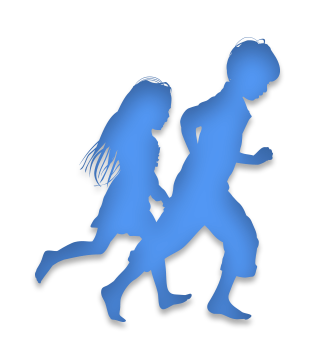
5 years old (approx.) – Age 8. Children under the age of 8 are required by law to ride in a car seat or booster seat appropriate for their height and weight, unless the parent has written documentation that the child is over 4’9” (57 inches).
Your child is ready for a booster seat once they have reached the maximum height or weight limit for his or her forward-facing car seat. Remember that with every step forward there is a reduction in the level of protection and safety. So don't rush to the next stage.
Georgia law requires that all children under the age of 8 whose height is less than 4'9" (57 inches) are required to be in either a car seat or a booster seat suitable for their age, height and weight and must ride in the backseat of a vehicle.
When using a booster seat, make sure the lap and shoulder belt fits properly. The lap belt must lie snugly across the upper thighs, not the stomach. The shoulder belt should lie snugly across the shoulder and chest and not cross the child's neck or face.
Many booster seats have a weight range starting at 30-40 pounds, with a maximum weight of 80-100+ pounds. The National Child Passenger Safety Board [10] recommends keeping your child in a booster seat until the vehicle seat belt fits your child properly, and he or she is mature enough to sit without slouching for the entire ride.
5 years old (approx.) – Age 8. Children under the age of 8 are required by law to ride in a car seat or booster seat appropriate for their height and weight, unless the parent has written documentation that the child is over 4’9” (57 inches).
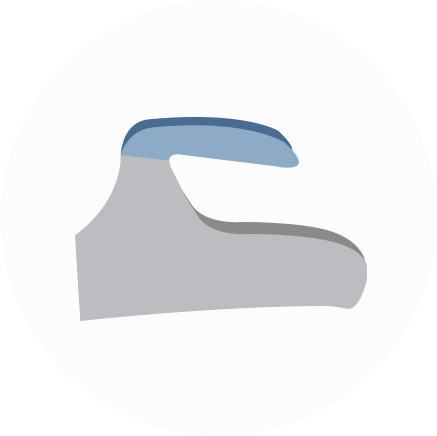

Age 8 and at least 4’9” (57 inches) per Georgia law, provided the seat belt fits properly without the use of a booster seat.
Children can transition from a booster seat to using a lap and shoulder belt only when they have reached age 8 and are at least 4’9” (57 inches) tall, as long as the seat belt fits properly.
For a seat belt to fit properly, the lap belt must lie snugly across the upper thighs, not the stomach. The shoulder belt should lie snugly across the shoulder and chest and not cross the neck or face.
The child must be able to sit with their back and hips against the vehicle seat back, their knees bent easily over the front edge of the seat, and sit in position without slouching for the entire ride.
Remember: children ages 12 and under should ride in the back seat. According to the CDC, airbags can kill young children riding in the front seat.
Buckling up is the most important thing you can do to protect yourself in the event of a crash.
Age 8 and at least 4’9” (57 inches) per Georgia law, provided the seat belt fits properly without the use of a booster seat.
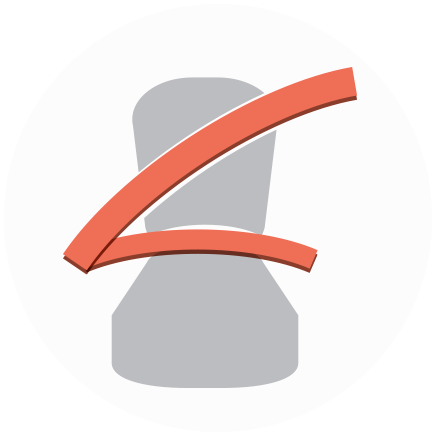
Download our printable guidelines
Car Seat Installation Videos:
Visit iRideSafe.com/media-gallery for easy-to-follow videos with steps to help you install your child’s car seat.
American Academy of Pediatrics. AAP Updates Recommendation of Car Seats. March 21, 2011. (cited 2016 December 15)
Governor's Office of Highway Safety in Georgia. (cited 2016 December 15)
http://www.gahighwaysafety.org/campaigns/child-passenger-safety/
National Highway Traffic Safety Administration. Putting Children First. November 2000 (cited 2016 December 15)
http://www.ntsb.gov/safety/safety-studies/Documents/SR0002.pdf
National Highway Traffic Safety Administration. Putting Children First. November 2000 (cited 2016 December 15)
http://www.ntsb.gov/safety/safety-studies/Documents/SR0002.pdf
American Academy of Pediatrics. AAP Updates Recommendation of Car Seats. March 21, 2011. (cited 2016 December 15)
National Highway Traffic Safety Administration. (cited December 20, 2016)
Governor’s Office of Highway Safety in Georgia. (cited 2016 December 15)
http://www.gahighwaysafety.org/campaigns/child-passenger-safety/
National Child Passenger Safety Board (cited 2016)
American Academy of Pediatrics. AAP Updates Recommendation of Car Seats. March 21, 2011. (cited 2016 December 15)
American Academy of Pediatrics. AAP Updates Recommendation of Car Seats. March 21, 2011. (cited 2016 December 15)
National Highway Traffic Safety Administration. Putting Children First. November 2000 (cited 2016 December 15)
http://www.ntsb.gov/safety/safety-studies/Documents/SR0002.pdf
National Highway Traffic Safety Administration. Putting Children First. November 2000 (cited 2016 December 15)
http://www.ntsb.gov/safety/safety-studies/Documents/SR0002.pdf
Governor's Office of Highway Safety in Georgia. (cited 2016 December 15)
http://www.gahighwaysafety.org/campaigns/child-passenger-safety/
American Academy of Pediatrics. AAP Updates Recommendation of Car Seats. March 21, 2011. (cited 2016 December 15)
American Academy of Pediatrics. AAP Updates Recommendation of Car Seats. March 21, 2011. (cited 2016 December 15)
National Highway Traffic Safety Administration. (cited December 20, 2016)
Governor’s Office of Highway Safety in Georgia. (cited 2016 December 15)
http://www.gahighwaysafety.org/campaigns/child-passenger-safety/
National Child Passenger Safety Board (cited 2016)